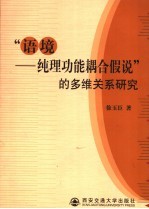

“语境-纯理功能耦合假说”的多维关系研究PDF电子书下载
- 电子书积分:11 积分如何计算积分?
- 作 者:徐玉臣著
- 出 版 社:西安:西安交通大学出版社
- 出版年份:2006
- ISBN:7560523218
- 页数:280 页
Chapter One Introduction 1
1.1 Theoretical backgrounds of the present study 1
1.2 The objectives of the present study 7
1.3 The organization of the book 12
Chapter Two The Notion of Context Revisited 14
2.1 Introduction 14
2.2 The socio-cultural approach to context of situation 18
2.2.1 The concept of context in pragmatics 18
2.2.1.1 Leech's view of speech situation 19
2.2.1.2 van Dijk's notion of context 20
2.2.1.3 Hymes'concept of speech situation:SPEAKING 22
2.2.1.4 Lyons'context of utterance 24
2.2.1.5 Gazdar's view of context 26
2.2.2 Context in Systemic Functional Linguistics 27
2.2.2.1 Context of situation in the pre-Halliday era(1):Malinowski's view 27
2.2.2.2 Context of situation in the pre-Halliday era(2):Firth's view 29
2.2.2.3 Context of situation as a socio-semiotic construct:the notion in SFL 31
2.3 The cognitive approach to the notion of context 34
2.3.1 Context as cognitive representation of the conceptual interaction 35
2.3.2 Context as domain 36
2.3.3 Context as frame 37
2.3.4 Context as script 39
2.4 The notion of context of situation in SFL revisited 40
2.4.1 Field of discourse 40
2.4.2 Tenor of discourse 45
2.4.3 Mode of discourse 48
2.5 Summary 50
Chapter Three Language Functions and Their Realizations 53
3.1 Introduction 53
3.2 Traditional views of language functions 56
3.2.1 Jakobson's categorization of language functions 56
3.2.2 Hymes'model of language functions 59
3.2.3 Brown&Yule's dichotomy 61
3.3 Metafunctions and their grammatical realizations 63
3.3.1 The ideational metafunction and its grammatical realization 66
3.3.1.1 Classification of processes 67
3.3.1.2 Internal structure of the process 69
3.3.2 The interpersonal metafunction and its grammatical realization 71
3.3.2.1 Mood 71
3.3.2.2 Modality 76
3.3.3 The textual metafunction and its realization 78
3.3.3.1 Structural resources 79
3.3.3.2 Non-structural resources:cohesive devices 84
3.4 Rethinking linguistic realizations of metafunctions 91
3.4.1 The ideational metafunction and its lexical realization 92
3.4.2 The interpersonal metafunction and its other realizations 94
3.4.3 The textual metafunction and nominalization 98
3.5 Summary 100
Chapter Four CMH Hypothesis Revisited 103
4.1 Introduction 103
4.2 CMH hypothesis 106
4.3 Field of discourse and ideational metafunction 108
4.3.1 Action-based vs. reflection-based fields 108
4.3.2 Specialized vs. non-specialized fields 115
4.3.3 Institutionalized vs. non-institutionalized fields 119
4.4 Tenor of discourse and interpersonal metafunction 122
4.4.1 Social distance and interpersonal metafunction 122
4.4.2 Affective involvement and interpersonal metafunction 125
4.4.3 Power and interpersonal metafunction 127
4.5 Mode of discourse and textual netafunction 129
4.5.1 Spontaneity and textual metafunction 129
4.5.2 Spatial/temporal distance and textual metafunction 134
4.5.3 Semiotic role and textual metafunction 138
4.6 Rethinking CMH Hypothesis 141
4.7 Summary 143
Chapter Five Interaction between Contextual Variables 146
5.1 Introduction 146
5.2 Impact of field upon tenor 147
5.2.1 Impact of subject matter upon tenor 148
5.2.2 Impact of arena upon tenor 152
5.2.3 Impact of semantic domain upon tenor 155
5.3 Impact of field upon mode 158
5.3.1 Impact of subject matter upon mode 159
5.3.2 Impact of arena upon mode 162
5.3.3 Impact of semantic domain upon mode 164
5.4 Impact of tenor upon field 168
5.4.1 Impact of social distance upon field 168
5.4.2 Impact of power upon field 173
5.4.3 Impact of affective involvement upon field 176
5.5 Impact of tenor upon mode 177
5.5.1 Impact of affective involvement upon mode 178
5.5.2 Impact of social distance upon mode 179
5.6 Impact of mode upon field 182
5.6.1 Impact of semiotic role upon field 182
5.6.2 Impact of spatial/temporal distance upon field 185
5.6.3 Impact of channel upon field 186
5.7 Impact of mode upon tenor 188
5.7.1 Impact of spontaneity upon tenor 189
5.7.2 Impact of genre upon tenor 191
5.8 Summary 194
Chapter Six CMH Hypothesis Revised:Multivariate Relation-ships between Contextual Variables and Metafunctions 198
6.1 Introduction 198
6.2 Impact of field upon interpersonal choices 200
6.2.1 Impact of field upon the selection of vocatives 200
6.2.2 Impact of field upon code-switching 201
6.2.3 Impact of field upon choices in mood 202
6.2.4 Impact of field upon choices in modality 206
6.3 Impact of field upon textual choices 210
6.3.1 Impact of field upon choices in the Thematic structure 210
6.3.2 Impact of field upon nominalization 214
6.4 Impact of tenor upon ideational choices 216
6.4.1 Impact of tenor upon the selection of the process per se 217
6.4.2 Impact of tenor upon the choice of participants and circumstances 220
6.5 Impact of tenor upon textual choices 224
6.5.1 Impact of tenor upon the employment of nominalization 224
6.5.2 Impact of tenor upon thematic choices 227
6.6 Impact of mode upon ideational choices 233
6.6.1 Impact of spontaneity upon ideational choices 234
6.6.2 Impact of the semiotic role of text upon ideational choices 237
6.7 Impact of mode upon interpersonal choices 240
6.7.1 Impact of spontaneity upon the choice of marked mood structures 240
6.7.2 Impact of spontaneity upon the choice of partial mood structures 244
6.8 Summary 246
Chapter Seven Conclusions 249
Bibliography 259
Appendix Ⅰ Specialized discourses selected for analysis 277
Appendix Ⅱ Non-specialized discourses selected for analysis 280
- 《SQL与关系数据库理论》(美)戴特(C.J.Date) 2019
- 《公共关系》胡杏菁,罗永全,连伟文主编 2018
- 《功能涂料》刘仁主编 2018
- 《海洋功能食品》王卉 2019
- 《功能食品 第2版》孟宪军 2017
- 《人际关系应用心理学》贾海泉 2018
- 《汉语韵律的多维特征及其认知功能》吴洁敏,朱宏达著 2019
- 《高校教师胜任力与工作绩效关系研究》曹志峰著 2019
- 《受试者性格与其英语互动交际能力的关系》楼荷英著 2018
- 《现代汉语空间位置关系虚拟运动研究》姚京晶著 2018
